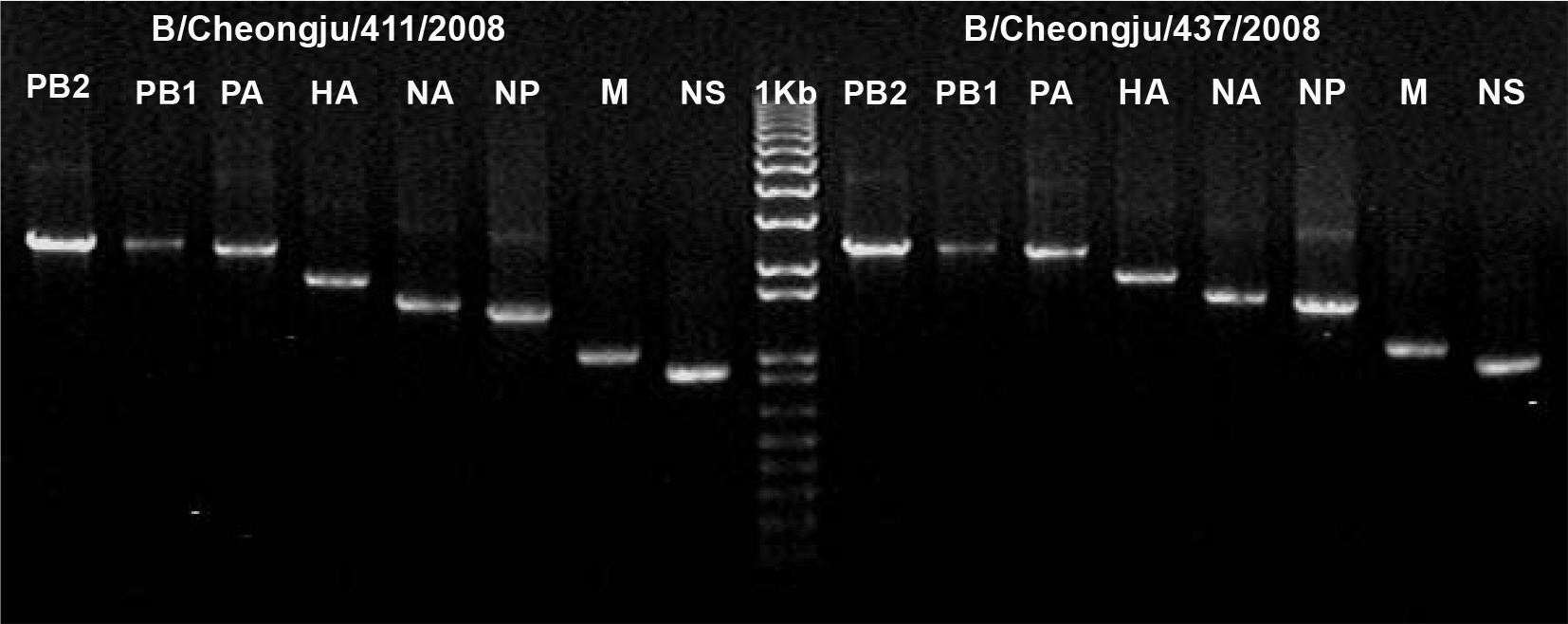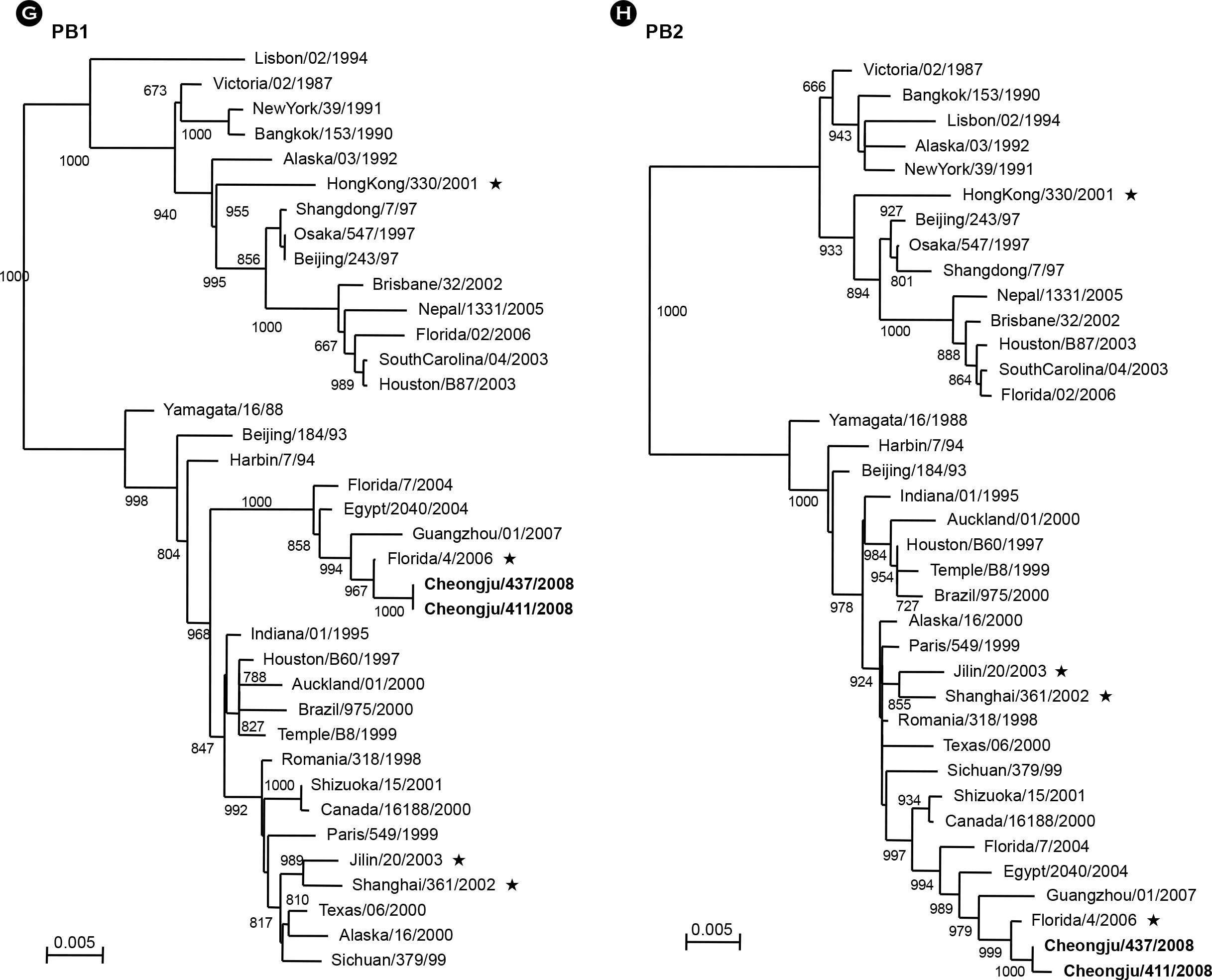J Bacteriol Virol.
2009 Jun;39(2):125-136. 10.4167/jbv.2009.39.2.125.
Genetic Characteristics and Phylogenetic Analysis of Influenza Type B Viruses Isolated from Nasopharyngeal Suction Samples of Korean Patients
- Affiliations
-
- 1College of Medicine and Medical Research Institute, Chungbuk National University, Cheongju, Korea. choiki55@chungbuk.ac.kr
- KMID: 1474173
- DOI: http://doi.org/10.4167/jbv.2009.39.2.125
Abstract
- To investigate the genetic characteristics of human influenza type B viruses circulating in Chungbuk province, Korea, we tested 510 clinical samples of nasopharyngeal suction from pediatric patients diagnosed with respiratory illness between June 2007 and June 2008. Twelve out of thirty-six isolates were identified as type B influenza virus by RT-PCR and sequencing analysis. Interestingly, genetic characterization of type B viruses isolated in this study revealed that all type B influenza viruses were the Yamagata lineages, a vaccine strains of southern hemisphere during 2007~2008, rather than the Victoria lineage of northern hemisphere during 2007~2008. Furthermore, there were a total of twelve unique mutations (HA: H40Y, D/G230S, V252M and K272R and NA: P3H, P/T/S42Q, N59S) occurred in our type B isolates. These results suggest that relative high prevalence of type B viruses in Korea during 2007~2008 season might be due to the wrong vaccine strains selection. Taken together, the results of this study demonstrate continuous evolutions of human type B viruses by antigenic drift and also highlight the need to closely monitoring of influenza viruses to aid the early detection of potentially pandemic strains as well as underscore the need for new therapeutics.
MeSH Terms
Figure
Reference
-
1). Jian JW., Lai CT., Kuo CY., Kuo SH., Hsu LC., Chen PJ., Wu HS., Liu MT. Genetic analysis and evaluation of the reassortment of influenza B viruses isolated in Taiwan during the 2004~2005 and 2006~2007 epidemics. Virus Res. 2008. 131:243–9.
Article2). Wright PF., Webster RG. Orthomyxoviruses. Fields K.D.M., Hawley B.N., editorsEditors,. Virology. Lippencott-Raven;Philadelphia: 2001. pp.p. 1533–79.3). Mitnaul LJ., Matrosovich MN., Castrucci MR., Tuzikov AB., Bovin NV., Kobasa D., Kawaoka Y. Balanced hemagglutinin and neuraminidase activities are critical for efficient replication of influenza A virus. J Virol. 2000. 74:6015–20.
Article4). Rota PA., Wallis TR., Harmon MW., Rota JS., Kendal AP., Nerome K. Cocirculation of two distinct evolutionary lineages of influenza type B virus since 1983. Virology. 1990. 175:59–68.
Article5). Xu X., Lindstrom SE., Shaw MW., Smith CB., Hall HE., Mungall BA., Subbarao K., Cox NJ., Klimov A. Reassortment and evolution of current human influenza A and B viruses. Virus Res. 2004. 103:55–60.
Article6). Betakova T., Nermut MV., Hay AJ. The NB protein is an integral component of the membrane of influenza B virus. J Gen Virol. 1996. 77:2689–94.
Article7). Brassard DL., Leser GP., Lamb RA. Influenza B virus NB glycoprotein is a component of the virion. Virology. 1996. 220:350–60.
Article8). Briedis DJ., Tobin M. Influenza B virus genome: complete nucleotide sequence of the influenza B/Lee/40 virus genome RNA segment 5 encoding the nucleoprotein and comparison with the B/Singapore/222/79 nucleoprotein. Virology. 1984. 133:448–55.
Article9). Briedis DJ., Lamb RA., Choppin PW. Sequence of RNA segment 7 of the influenza B virus genome: partial amino acid homology between the membrane proteins (M1) of influenza A and B viruses and conservation of a second open reading frame. Virology. 1982. 116:581–8.
Article10). Kanegae Y., Sugita S., Endo A., Ishida M., Senya S., Osako K., Nerome K., Oya A. Evolutionary pattern of the hemagglutinin gene of influenza B viruses isolated in Japan: cocirculating lineages in the same epidemic season. J Virol. 1990. 64:2860–5.
Article11). Rota PA., Hemphill ML., Whistler T., Regnery HL., Kendal AP. Antigenic and genetic characterization of the haemagglutinins of recent cocirculating strains of influenza B virus. J Gen Virol. 1992. 73:2737–42.
Article12). Air GM., Gibbs AJ., Laver WG., Webster RG. Evolutionary changes in influenza B are not primarily governed by antibody selection. Proc Natl Acad Sci USA. 1990. 87:3884–8.
Article13). Luo C., Morishita T., Satou K., Tateno Y., Nakajima K., Nobusawa E. Evolutionary pattern of influenza B viruses based on the HA and NS genes during 1940 to 1999: origin of the NS genes after 1997. Arch Virol. 1999. 144:1881–91.
Article14). McCullers JA., Wang GC., He S., Webster RG. Reassortment and insertion-deletion are strategies for the evolution of influenza B viruses in nature. J Virol. 1999. 73:7343–8.
Article15). Nerome R., Hiromoto Y., Sugita S., Tanabe N., Ishida M., Matsumoto M., Lindstrom SE., Takahashi T., Nerome K. Evolutionary characteristics of influenza B virus since its first isolation in 1940: dynamic circulation of deletion and insertion mechanism. Arch Virol. 1998. 143:1569–83.
Article16). Barr IG., Komadina N., Hurt A., Shaw R., Durrant C., Iannello P., Tomasov C., Sjogren H., Hampson AW. Reassortants in recent human influenza A and B isolates from South East Asia and Oceania. Virus Res. 2003. 98:35–44.
Article17). Chen GW., Shih SR., Hsiao MR., Chang SC., Lin SH., Sun CF., Tsao KC. Multiple genotypes of influenza B viruses cocirculated in Taiwan in 2004 and 2005. J Clin Microbiol. 2007. 45:1515–22.
Article18). Nah SY., Park SE., Park JY., Lee HJ. Epidemiology of influenza virus over 8 years (1990~1998) in Seoul, Korea. Korean J Infect Dis. 1999. 31:210–6.19). KCDC. Influenza Sentinel Surveillance Report, 2007~2008. Number 29. 2008.20). Yamashita M., Krystal M., Fitch WM., Palese P. Influenza B virus evolution: co-circulating lineages and comparison of evolutionary pattern with those of influenza A and C viruses. Virology. 1988. 163:112–22.
Article21). Pechirra P., Nunes B., Coelho A., Ribeiro C., Gonçalves P., Pedro S., Castro LC., Rebelo-de-Andrade H. Molecular characterization of the HA gene of influenza type B viruses. J Med Virol. 2005. 77:541–9.
Article22). Lindstrom SE., Hiromoto Y., Nishimura H., Saito T., Nerome R., Nerome K. Comparative analysis of evolutionary mechanisms of the hemagglutinin and three internal protein genes of influenza B virus: multiple cocirculating lineages and frequent reassortment of the NP, M, and NS genes. J Virol. 1999. 73:4413–26.
Article23). Hwang YO., Seo BT., Choi BY. Analysis of isolation and subtyping of influenza virus in Seoul, during 1999~2003. J Bacteriol Virol. 2004. 34:67–74.24). Hoffmann E., Mahmood K., Yang CF., Webster RG., Greenberg HB., Kemble G. Rescue of influenza B virus from eight plasmids. Proc Natl Acad Sci USA. 2002. 99:11411–6.
Article25). Stockton J., Ellis JS., Saville M., Clewley JP., Zambon MC. Multiplex PCR for typing and subtyping influenza and respiratory syncytial viruses. J Clin Microbiol. 1998. 36:2990–5.
Article
- Full Text Links
- Actions
-
Cited
- CITED
-
- Close
- Share
- Similar articles
-
- Genome characterization and mutation analysis of human influenza A virus in Thailand
- Genetic Characterization of Haemagglutinin 1 Domain of Influenza B Viruses Isolated in Korea during 1988~1999
- Genetic diversity of the H5N1 viruses in live bird markets, Indonesia
- Genetic characterization of H9N2 avian influenza virus previously unrecognized in Korea
- The Emergence of Oseltamivir-Resistant Seasonal Influenza A (H1N1) Virus in Korea During the 2008-2009 Season



